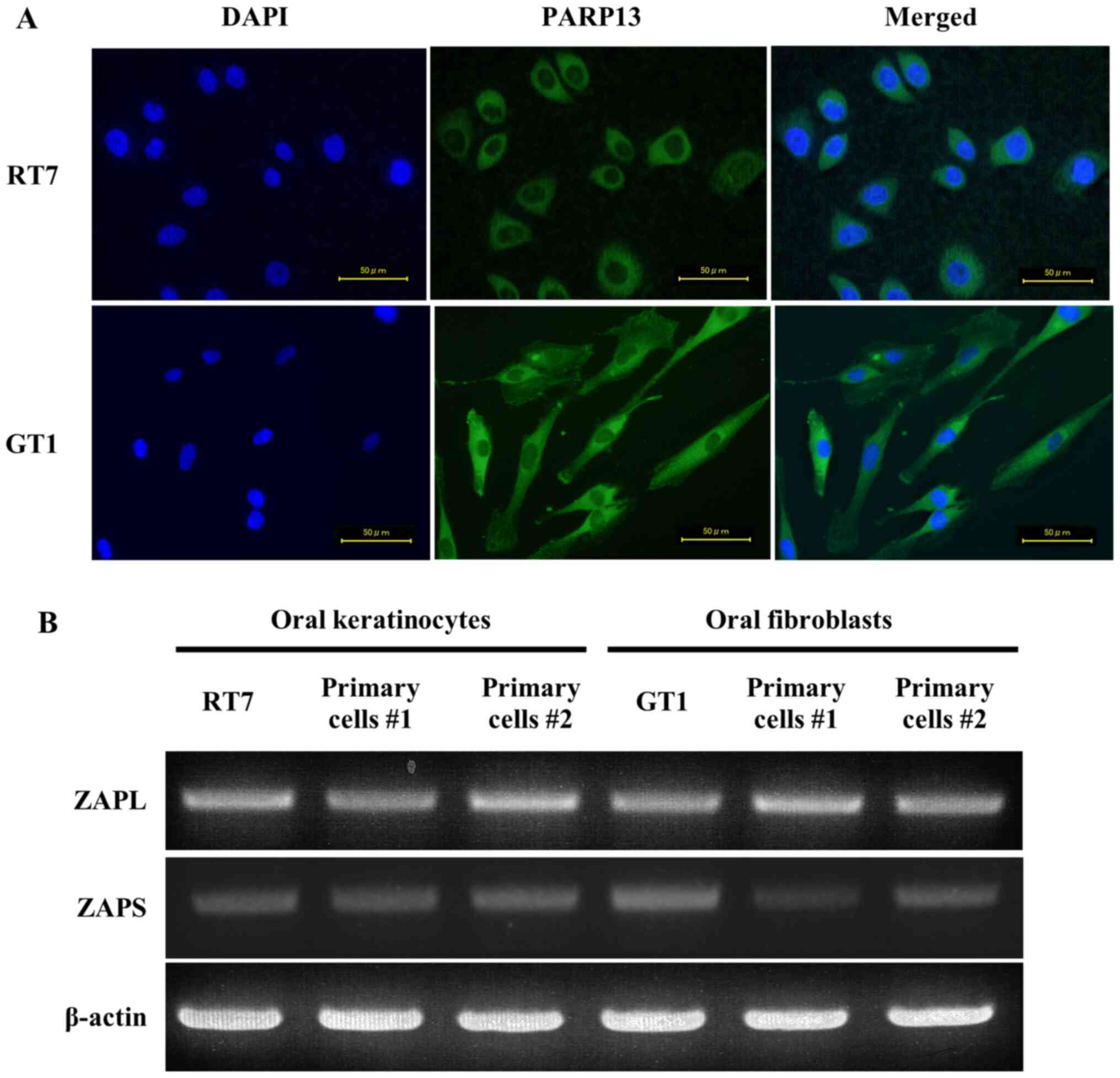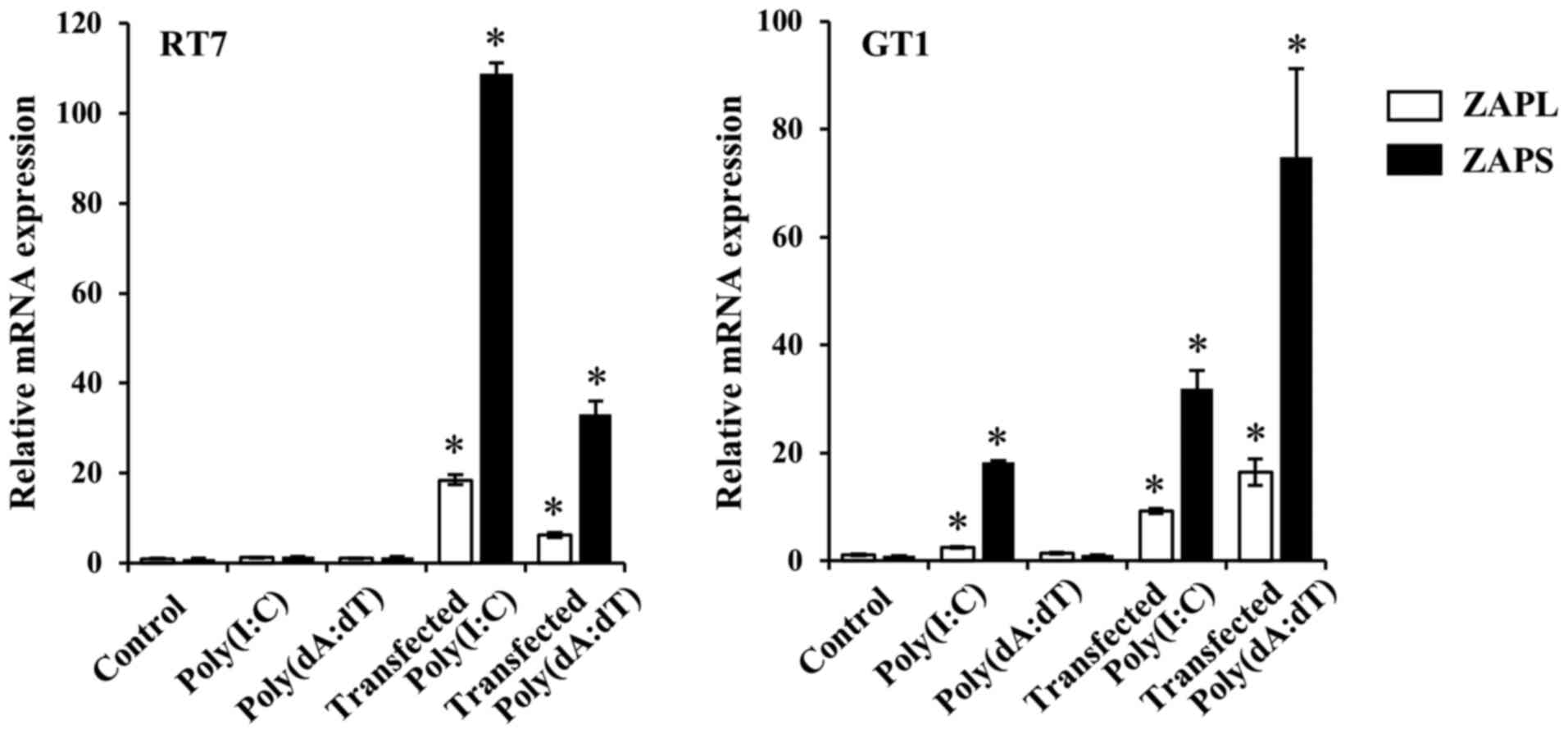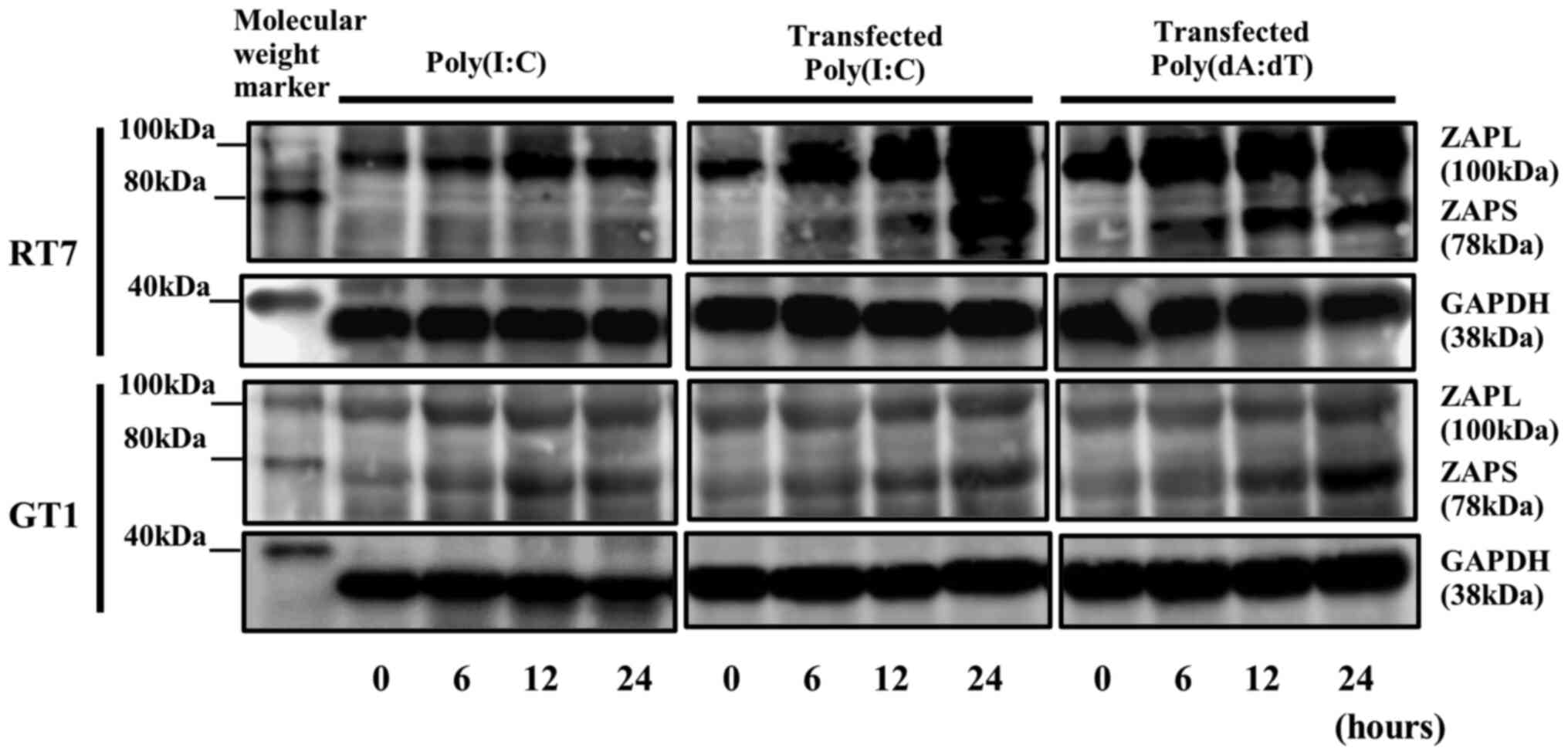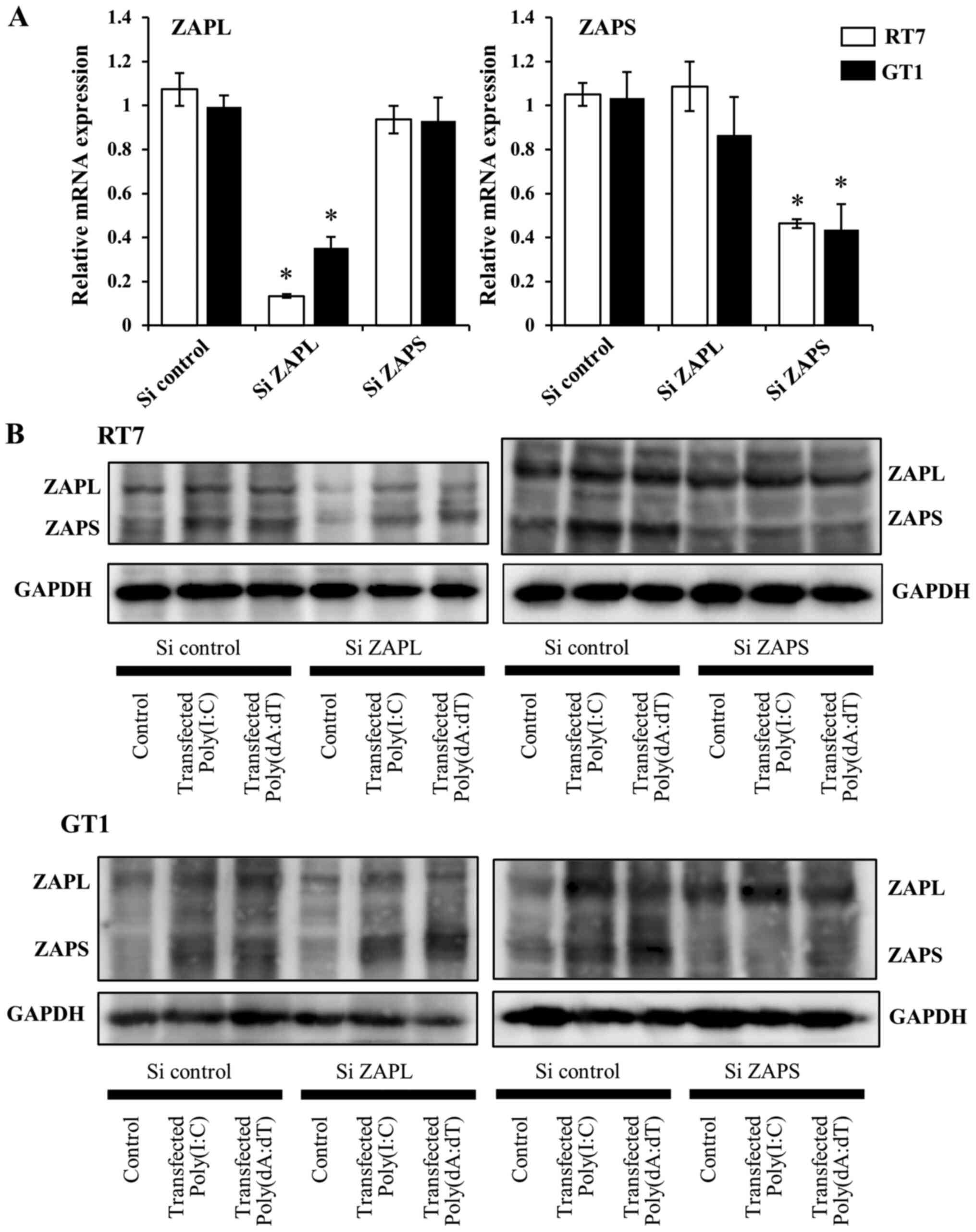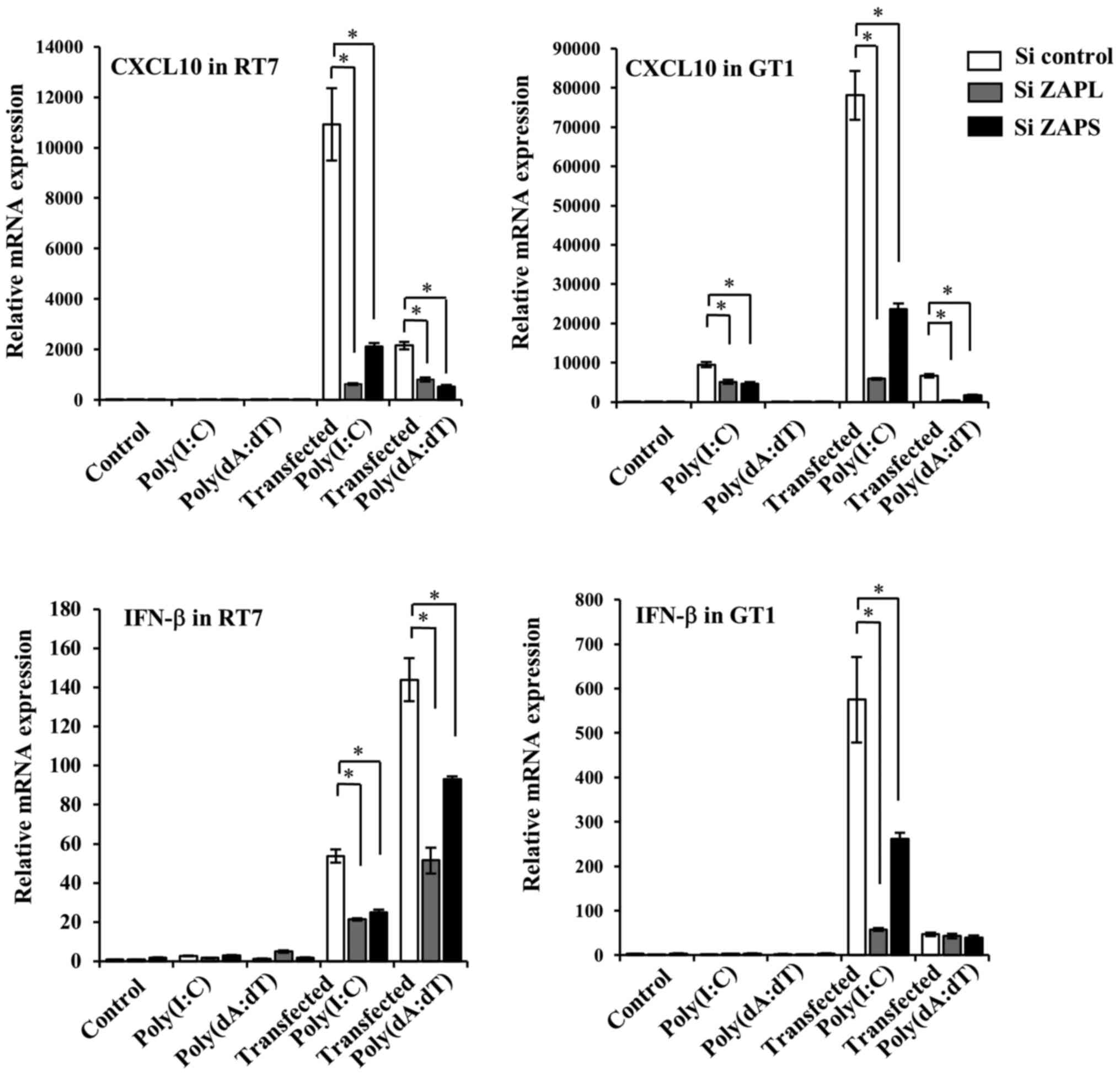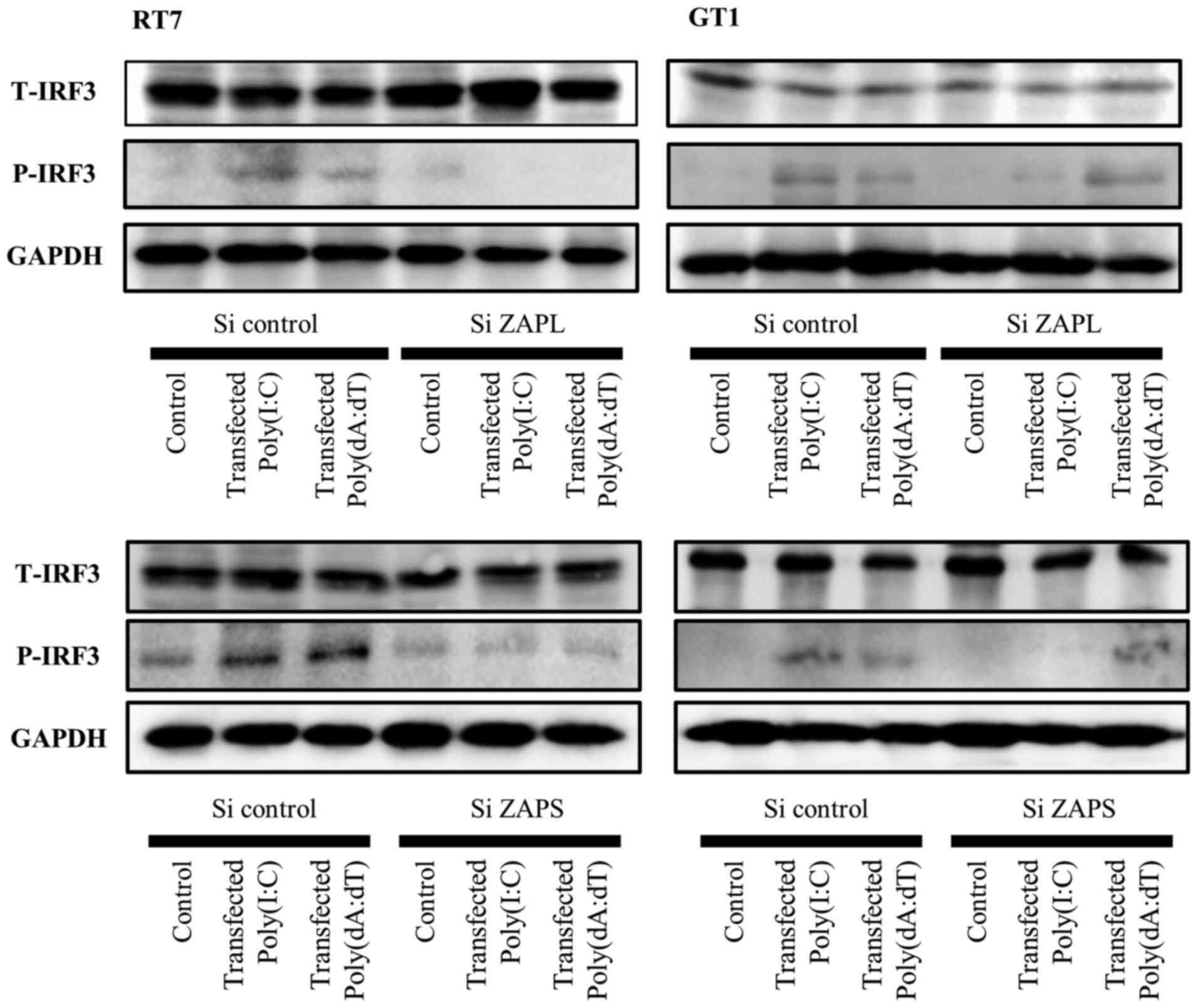|
1
|
Fukui A, Ohta K, Nishi H, Shigeishi H,
Tobiume K, Takechi M and Kamata N: Interleukin-8 and CXCL10
expression in oral keratinocytes and fibroblasts via Toll-like
receptors. Microbiol Immunol. 57:198–206. 2013. View Article : Google Scholar : PubMed/NCBI
|
|
2
|
Beklen A, Hukkanen M, Richardson R and
Konttinen YT: Immunohistochemical localization of Toll-like
receptors 1–10 in periodontitis. Oral Microbiol Immunol.
23:425–431. 2008. View Article : Google Scholar : PubMed/NCBI
|
|
3
|
Mahanonda R, Sa-Ard-Iam N, Montreekachon
P, Pimkhaokham A, Yongvanichit K, Fukuda MM and Pichyangkul S: IL-8
and IDO expression by human gingival fibroblasts via TLRs. J
Immunol. 178:1151–1157. 2007. View Article : Google Scholar : PubMed/NCBI
|
|
4
|
Desmet CJ and Ishii KJ: Nucleic acid
sensing at the interface between innate and adaptive immunity in
vaccination. Nat Rev Immunol. 12:479–491. 2012. View Article : Google Scholar : PubMed/NCBI
|
|
5
|
Yoneyama M, Kikuchi M, Natsukawa T,
Shinobu N, Imaizumi T, Miyagishi M, Taira K, Akira S and Fujita T:
The RNA helicase RIG-I has an essential function in double-stranded
RNA-induced innate antiviral responses. Nat Immunol. 5:730–737.
2004. View
Article : Google Scholar : PubMed/NCBI
|
|
6
|
Ohta K, Fukui A, Shigeishi H, Ishida Y,
Nishi H, Tobiume K, Takechi M and Kamata N: Expression and function
of RIG-I in oral keratinocytes and fibroblasts. Cell Physiol
Biochem. 34:1556–1565. 2014. View Article : Google Scholar : PubMed/NCBI
|
|
7
|
Gao G, Guo X and Goff SP: Inhibition of
retroviral RNA production by ZAP, a CCCH-type zinc finger protein.
Science. 297:1703–1706. 2002. View Article : Google Scholar : PubMed/NCBI
|
|
8
|
Schreiber V, Dantzer F, Ame JC and de
Murcia G: Poly(ADP-ribose): Novel functions for an old molecule.
Nat Rev Mol Cell Biol. 7:517–528. 2006. View Article : Google Scholar : PubMed/NCBI
|
|
9
|
Hakmé A, Wong HK, Dantzer F and Schreiber
V: The expanding field of poly(ADP-ribosyl)ation reactions.
‘Protein Modifications: Beyond the Usual Suspects’ Review Series.
EMBO Rep. 9:1094–1100. 2008. View Article : Google Scholar : PubMed/NCBI
|
|
10
|
Zhu H, Tang YD, Zhan G, Su C and Zheng C:
The critical role of PARPs in regulating innate immune responses.
Front Immunol. 12:7125562021. View Article : Google Scholar : PubMed/NCBI
|
|
11
|
Malgras M, Garcia M, Jousselin C, Bodet C
and Lévêque N: The antiviral activities of Poly-ADP-ribose
polymerases. Viruses. 13:5822021. View Article : Google Scholar : PubMed/NCBI
|
|
12
|
Luo X, Wang X, Gao Y, Zhu J, Liu S, Gao G
and Gao P: molecular mechanism of RNA recognition by zinc-finger
antiviral protein. Cell Rep. 30:46–52.e4. 2020. View Article : Google Scholar : PubMed/NCBI
|
|
13
|
Zhu M, Zhou J, Liang Y, Nair V, Yao Y and
Cheng Z: CCCH-type zinc finger antiviral protein mediates antiviral
immune response by activating T cells. J Leukoc Biol. 107:299–307.
2020. View Article : Google Scholar : PubMed/NCBI
|
|
14
|
Chiu HP, Chiu H, Yang CF, Lee YL, Chiu FL,
Kuo HC, Lin RJ and Lin YL: Inhibition of Japanese encephalitis
virus infection by the host zinc-finger antiviral protein. PLoS
Pathog. 14:e10071662018. View Article : Google Scholar : PubMed/NCBI
|
|
15
|
Zhang Y, Burke CW, Ryman KD and Klimstra
WB: Identification and characterization of interferon-induced
proteins that inhibit alphavirus replication. J Virol.
81:11246–11255. 2007. View Article : Google Scholar : PubMed/NCBI
|
|
16
|
Mao R, Nie H, Cai D, Zhang J, Liu H, Yan
R, Cuconati A, Block TM, Guo JT and Guo H: Inhibition of hepatitis
B virus replication by the host zinc finger antiviral protein. PLoS
Pathog. 9:e10034942013. View Article : Google Scholar : PubMed/NCBI
|
|
17
|
Tang Q, Wang X and Gao G: The short form
of the zinc finger antiviral protein inhibits influenza a virus
protein expression and is antagonized by the virus-encoded NS1. J
Virol. 91:e01909–e01916. 2017. View Article : Google Scholar : PubMed/NCBI
|
|
18
|
Kerns JA, Emerman M and Malik HS: Positive
selection and increased antiviral activity associated with the
PARP-containing isoform of human zinc-finger antiviral protein.
PLoS Genet. 4:e212008. View Article : Google Scholar : PubMed/NCBI
|
|
19
|
Li MM, Lau Z, Cheung P, Aguilar EG,
Schneider WM, Bozzacco L, Molina H, Buehler E, Takaoka A, Rice CM,
et al: TRIM25 enhances the antiviral action of zinc-finger
antiviral protein (ZAP). PLoS Pathog. 13:e10061452017. View Article : Google Scholar : PubMed/NCBI
|
|
20
|
Gonzalez-Perez AC, Stempel M, Wyler E,
Urban C, Piras A, Hennig T, Ganskih S, Wei Y, Heim A, Landthaler M,
et al: The zinc finger antiviral protein ZAP restricts human
cytomegalovirus and selectively binds and destabilizes viral
UL4/UL5 transcripts. MBio. 12:e02683–e20. 2021. View Article : Google Scholar : PubMed/NCBI
|
|
21
|
Hayakawa S, Shiratori S, Yamato H,
Kameyama T, Kitatsuji C, Kashigi F, Goto S, Kameoka S, Fujikura D,
Yamada T, et al: ZAPS is a potent stimulator of signaling mediated
by the RNA helicase RIG-I during antiviral responses. Nat Immunol.
12:37–44. 2011. View
Article : Google Scholar : PubMed/NCBI
|
|
22
|
Liu HM and Gale M Jr: ZAPS electrifies
RIG-I signaling. Nat Immunol. 12:11–12. 2011. View Article : Google Scholar : PubMed/NCBI
|
|
23
|
Schwerk J, Soveg FW, Ryan AP, Thomas KR,
Hatfield LD, Ozarkar S, Forero A, Kell AM, Roby JA, So L, et al:
RNA-binding protein isoforms ZAP-S and ZAP-L have distinct
antiviral and immune resolution functions. Nat Immunol.
20:1610–1620. 2019. View Article : Google Scholar : PubMed/NCBI
|
|
24
|
Fujimoto R, Kamata N, Yokoyama K, Taki M,
Tomonari M, Tsutsumi S, Yamanouchi K and Nagayama M: Establishment
of immortalized human oral keratinocytes by gene transfer of a
telomerase component. J Jpn Oral Muco Membr. 8:1–8. 2002.
View Article : Google Scholar
|
|
25
|
Kamata N, Fujimoto R, Tomonari M, Taki M,
Nagayama M and Yasumoto S: Immortalization of human dental papilla,
dental pulp, periodontal ligament cells and gingival fibroblasts by
telomerase reverse transcriptase. J Oral Pathol Med. 33:417–423.
2004. View Article : Google Scholar : PubMed/NCBI
|
|
26
|
Ohta K, Shigeishi H, Taki M, Nishi H,
Higashikawa K, Takechi M and Kamata N: Regulation of CXCL9/10/11 in
oral keratinocytes and fibroblasts. J Dent Res. 87:1160–1165. 2008.
View Article : Google Scholar : PubMed/NCBI
|
|
27
|
Gröger S, Michel J and Meyle J:
Establishment and characterization of immortalized human gingival
keratinocyte cell lines. J Periodontal Res. 43:604–614. 2008.
View Article : Google Scholar : PubMed/NCBI
|
|
28
|
Kato H, Sato S, Yoneyama M, Yamamoto M,
Uematsu S, Matsui K, Tsujimura T, Takeda K, Fujita T, Takeuchi O,
et al: Cell type-specific involvement of RIG-I in antiviral
response. Immunity. 23:19–28. 2005. View Article : Google Scholar : PubMed/NCBI
|
|
29
|
Ablasser A, Bauernfeind F, Hartmann G,
Latz E, Fitzgerald KA and Hornung V: RIG-I-dependent sensing of
poly(dA:dT) through the induction of an RNA polymerase
III-transcribed RNA intermediate. Nat Immunol. 10:1065–1072. 2009.
View Article : Google Scholar : PubMed/NCBI
|
|
30
|
Naruse T, Ohta K, Kato H, Ishida Y,
Shigeishi H, Sakuma M, Fukui A, Nakagawa T, Tobiume K, Nishi H, et
al: Immune response to cytosolic DNA via intercellular receptor
modulation in oral keratinocytes and fibroblasts. Oral Dis. Nov
17–2020.(Epub ahead of print). doi: 10.1111/odi.13725. PubMed/NCBI
|
|
31
|
Tsuchida T, Kawai T, Akira S and Tsuchida
T: Inhibition of IRF3-dependent antiviral responses by cellular and
viral proteins. Cell Res. 19:3–4. 2009. View Article : Google Scholar : PubMed/NCBI
|
|
32
|
Bick MJ, Carroll JW, Gao G, Goff SP, Rice
CM and MacDonald MR: Expression of the zinc-finger antiviral
protein inhibits alphavirus replication. J Virol. 77:11555–11562.
2003. View Article : Google Scholar : PubMed/NCBI
|
|
33
|
Müller S, Möller P, Bick MJ, Wurr S,
Becker S, Günther S and Kümmerer BM: Inhibition of filovirus
replication by the zinc finger antiviral protein. J Virol.
81:2391–2400. 2007. View Article : Google Scholar : PubMed/NCBI
|
|
34
|
Zhu M, Ma X, Cui X, Zhou J, Li C, Huang L,
Shang Y and Cheng Z: Inhibition of avian tumor virus replication by
CCCH-type zinc finger antiviral protein. Oncotarget. 8:58865–58871.
2017. View Article : Google Scholar : PubMed/NCBI
|
|
35
|
Todorova T, Bock FJ and Chang P: PARP13
regulates cellular mRNA post-transcriptionally and functions as a
pro-apoptotic factor by destabilizing TRAILR4 transcript. Nat
Commun. 5:53622014. View Article : Google Scholar : PubMed/NCBI
|
|
36
|
Lee H, Komano J, Saitoh Y, Yamaoka S,
Kozaki T, Misawa T, Takahama M, Satoh T, Takeuchi O, Yamamoto N, et
al: Zinc-finger antiviral protein mediates retinoic acid inducible
gene I-like receptor-independent antiviral response to murine
leukemia virus. Proc Natl Acad Sci USA. 110:12379–12384. 2013.
View Article : Google Scholar : PubMed/NCBI
|
|
37
|
Vyas S, Chesarone-Cataldo M, Todorova T,
Huang YH and Chang P: A systematic analysis of the PARP protein
family identifies new functions critical for cell physiology. Nat
Commun. 4:22402013. View Article : Google Scholar : PubMed/NCBI
|
|
38
|
Todorova T, Bock FJ and Chang P:
Poly(ADP-ribose) polymerase-13 and RNA regulation in immunity and
cancer. Trends Mol Med. 21:373–384. 2015. View Article : Google Scholar : PubMed/NCBI
|
|
39
|
Wang N, Dong Q, Li J, Jangra RK, Fan M,
Brasier AR, Lemon SM, Pfeffer LM and Li K: Viral induction of the
zinc finger antiviral protein is IRF3-dependent but
NF-kappaB-independent. J Biol Chem. 285:6080–6090. 2010. View Article : Google Scholar : PubMed/NCBI
|
|
40
|
Müller U, Steinhoff U, Reis LF, Hemmi S,
Pavlovic J, Zinkernagel RM and Aguet M: Functional role of type I
and type II interferons in antiviral defense. Science.
264:1918–1921. 1994. View Article : Google Scholar : PubMed/NCBI
|
|
41
|
Kadowaki N, Antonenko S, Lau JY and Liu
YJ: Natural interferon alpha/beta-producing cells link innate and
adaptive immunity. J Exp Med. 192:219–226. 2000. View Article : Google Scholar : PubMed/NCBI
|
|
42
|
Qin S, Rottman JB, Myers P, Kassam N,
Weinblatt M, Loetscher M, Koch AE, Moser B and Mackay CR: The
chemokine receptors CXCR3 and CCR5 mark subsets of T cells
associated with certain inflammatory reactions. J Clin Invest.
101:746–754. 1998. View Article : Google Scholar : PubMed/NCBI
|
|
43
|
Dufour JH, Dziejman M, Liu MT, Leung JH,
Lane TE and Luster AD: IFN-gamma-inducible protein 10 (IP-10;
CXCL10)-deficient mice reveal a role for IP-10 in effector T cell
generation and trafficking. J Immunol. 168:3195–3204. 2002.
View Article : Google Scholar : PubMed/NCBI
|















